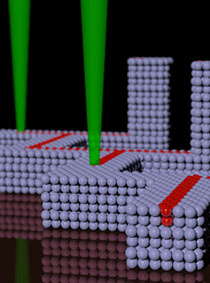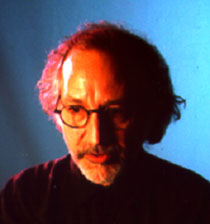|
|
NIT Strategic Workshop
|
Emerging Technologies for Future Optical and Wireless Networks
September 8 & 9, 2003
Towards the Synthetic All-Optical Computer: Science Fiction or Reality?
Geoffrey A Ozin
Materials Chemistry Research Group, University of Toronto
 Abstract. The 3-D photonic crystal can be thought of as the optical analogue of the semiconductor. While 3-D photonic crystals exist on the photonics road map the science and technology is still in the earliest phases of development and there are many crucial questions that still need to be addressed. These questions include, is computing with light in microphotonic crystal chips science fiction or reality? What are the materials challenges that have to be surmounted to reduce such an integrated microphotonic crystal chip to practice? Will top-down microfabrication or bottom-up self-assembly or a creative fusion of these two methodologies, directed self-assembly, enable microphotonic crystal chips to be manufactured? Can the degree of microstructural perfection, level of intrinsic defects and quality of extrinsic defects, all demanded for effective photon control in miniature optical circuits with minimal light losses, be engineered to photonic crystal specifications? The aim of this lecture is to take critical look at some developments in microsphere self-assembly of colloidal photonic crystals from the perspective of research results that have recently emerged from our materials chemistry group. The discussion will center on our group’s provocative vision of the colloidal photonic crystal all-optical chip depicted in the figure. It is intended to bring to the forefront whether state-of-the-art versions of colloidal photonic crystals and their planarization and integration on chips, can rise to the stringent specifications of structural perfection and optical quality, functionality and complexity that will be demanded for optical devices and circuits pictured for next generation all-optical chip and telecommunication technologies. Abstract. The 3-D photonic crystal can be thought of as the optical analogue of the semiconductor. While 3-D photonic crystals exist on the photonics road map the science and technology is still in the earliest phases of development and there are many crucial questions that still need to be addressed. These questions include, is computing with light in microphotonic crystal chips science fiction or reality? What are the materials challenges that have to be surmounted to reduce such an integrated microphotonic crystal chip to practice? Will top-down microfabrication or bottom-up self-assembly or a creative fusion of these two methodologies, directed self-assembly, enable microphotonic crystal chips to be manufactured? Can the degree of microstructural perfection, level of intrinsic defects and quality of extrinsic defects, all demanded for effective photon control in miniature optical circuits with minimal light losses, be engineered to photonic crystal specifications? The aim of this lecture is to take critical look at some developments in microsphere self-assembly of colloidal photonic crystals from the perspective of research results that have recently emerged from our materials chemistry group. The discussion will center on our group’s provocative vision of the colloidal photonic crystal all-optical chip depicted in the figure. It is intended to bring to the forefront whether state-of-the-art versions of colloidal photonic crystals and their planarization and integration on chips, can rise to the stringent specifications of structural perfection and optical quality, functionality and complexity that will be demanded for optical devices and circuits pictured for next generation all-optical chip and telecommunication technologies.
 Biography. Geoffrey Alan Ozin, studied at London, Oxford and Southampton Universities, joined the University of Toronto in 1969 where he is now Government of Canada Research Chair in materials chemistry and University Professor as well as Honorary Professor at The Royal Institution of Great Britain and University College London. His materials research includes supramolecular chemistry (chemistry beyond the molecule), materials self-assembly (chemistry approach to inorganic materials with complex form), biomimetic inorganic chemistry (copying the chemistry of biomineralization), nanochemistry (chemistry at the nanometre scale), inorganic-organic hybrid materials (chemical strategies to nanocomposites) and photonic materials chemistry (chemistry control of the flow of light). This involves a “panoscopic” way of thinking about materials, introducing the notion of chemistry over “all” scales through hierarchical assembly, leading to complexity in materials chemistry, previously the domain of the living materials world. Biography. Geoffrey Alan Ozin, studied at London, Oxford and Southampton Universities, joined the University of Toronto in 1969 where he is now Government of Canada Research Chair in materials chemistry and University Professor as well as Honorary Professor at The Royal Institution of Great Britain and University College London. His materials research includes supramolecular chemistry (chemistry beyond the molecule), materials self-assembly (chemistry approach to inorganic materials with complex form), biomimetic inorganic chemistry (copying the chemistry of biomineralization), nanochemistry (chemistry at the nanometre scale), inorganic-organic hybrid materials (chemical strategies to nanocomposites) and photonic materials chemistry (chemistry control of the flow of light). This involves a “panoscopic” way of thinking about materials, introducing the notion of chemistry over “all” scales through hierarchical assembly, leading to complexity in materials chemistry, previously the domain of the living materials world.
More info: Prof. Ozin's web page
|
|
|


